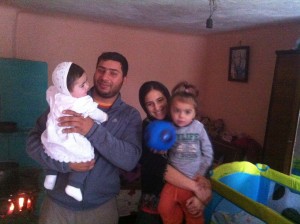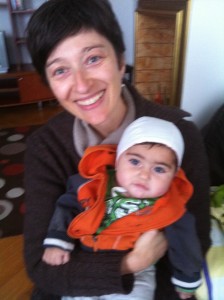Thin girl versus thick bureaucracy. A few thoughts on structural violence against children.
Last year, on a hot summer day, in a big rush, I had just missed my subway train. Desperately running on the stairs and then the doors closing on me. The only other person on the platform was a very thin girl with a small baby in her arms. She looked sad and exhausted and I felt sorry for her. At least I did not have to carry somebody in my arms. When other people arrived, the girl started to ask for money. I realized it was only me who had missed the train. She was there to ‘work’. To produce some income from begging. I got furious: just the day before I had read about a new begging scam that involved drugging children so that they look like peaceful little angels. I started to follow the girl to see if the child was moving. She was not moving. Maybe she was drugged. Or even dead: the article suggested that many children were drugged to death. I went to the girl to check on the baby. I asked if the baby was hers and if she was fine. The baby woke up and the girl started to breast feed her to show me she is hers. Scared, but dignified, the mother told me that she only comes to beg when they are very hungry at home. Life was harsh on her: she was 17 and this was only her younger child. A second child, a boy, was waiting for her at home. Along with 10 or so files at the Police Station for begging, which is an offense in Romania.
So much is said and written about violence against children. Almost ten years ago The United Nations Secretary General produced a special study to look into the matter from a global point of view. The study looked at violence against children that takes place in the home and the family, in schools and educational settings, in care and justice systems, in work settings and in the community. Sadly, the study discovered that violence against children remains ‘legal, State-authorized and socially approved’.
The study was informed by Article 19 of the United Nations Convention on the Rights of the Child (UNCRC), which defines violence against children as ‘all forms of physical or mental violence, injury or abuse, neglect or negligent treatment, maltreatment or exploitation, including sexual abuse’. It also drew on the definition in the World Report on Violence and Health (2002): “the intentional use of physical force or power, threatened or actual, against a child, by an individual or group, that either results in or has a high likelihood of resulting in actual or potential harm to the child’s health, survival, development or dignity’. These two definitions suggest that the primary offenders are individuals such as parents or care-takers. Both definitions remain silent about the structural violence that is often the real criminal.

As I discovered, the girl in my story was not directly abused by anybody. She was not forced to beg. Her family had an equally hard life and they simply could not help her. She was not forced to get pregnant – it just happened to her and the second time she got pregnant she wanted to get an abortion, but she did not have enough money to do it. She was not forced to leave school: she simply could not afford it any longer. There is no ‘individual’ or group who could be blamed for her exhaustion, but she was surely in an abusive situation: a kid who needed to take care of herself and two other kids.
There is a social order that allows girls like her to suffer endlessly. This social order is not only unfair, it kills: it produces high infant mortality rates, it produces infanticides, maternal death, gender selective abortions, premature deaths of children and parents and so on.
Many decades ago Galtung had defined structural violence as any institutional arrangement that, by its very operation, regularly causes physical or psychological harm to a certain portion of the population or imposes limits on their freedom. Children who die of malnutrition are victims of structural violence as there is plenty of food in the world, but the functioning of the world is constructed in such a way so as to allow children to die.
One important aspect of structural violence is that it is often hard to see, although it is in plain view. We all know that children die of hunger in the world. We all see children begging in the streets. But we are all confused about assigning culpability. When a baby dies of malnutrition, should we blame his poor parents, the government, the local authorities, the medical system?
Fighting structural violence is daunting. The ‘institutional arrangements’ mentioned by Galtung in his definition are so complex that they make the mission overwhelming if not impossible. Complexity, more than any individual or group of individuals, becomes the real enemy. When the culprit is an individual person, measures can be taken to extract the child from the dangerous situation. But what should we do when responsibility cannot be assigned because the child’s situation is too complex?
At ChildPact we started to think that one immediate thing we could do is to begin to understand complexity itself. The first ‘institutional arrangements’ that we want to look at are the bureaucratic procedures, terminology and institutions. If a child protection bureaucracy is too complicated for a child to understand it, it means that something is wrong with that bureaucracy. If not even parents understand it, then it means that everything is wrong with it. And if not even child protection professionals can navigate it easily at all times, then it means that it has to change radically and quickly. The complexity of the child protection bureaucracies is well known and many child rights activists think about the violence of bureaucracies as a form, like any other, of violence against children.
To paraphrase de Bono (who inspired us for this new strand of work), understanding is excellent but not good enough. Understanding should be followed by action. In other words, after understanding the causes and inner workings of harmful bureaucratic complexity, we want to explore ways for promoting its simplification. A brainstorm in this sense will be conducted during ChildPact’s first Simplicity Workshops to take place in April – May in Serbia, Kosovo, Bosnia and Herzegovina, Montenegro and Albania.
 In the meantime the thin girl in my story is doing a bit better. With the help of some friends and some people who joined after I wrote a few blog posts, we created a donors’ circle for her. We took her to the dentist (she had excruciating pain), to the gynecologist (to prevent unwanted pregnancies), we donated clothes, food and other badly needed items and now we are trying to help her and her husband build a small house. Social services, alerted by a friend who is a member of the Romanian Parliament, visited her and gave her a baby stroller and advised her to seek family planning counselling.
In the meantime the thin girl in my story is doing a bit better. With the help of some friends and some people who joined after I wrote a few blog posts, we created a donors’ circle for her. We took her to the dentist (she had excruciating pain), to the gynecologist (to prevent unwanted pregnancies), we donated clothes, food and other badly needed items and now we are trying to help her and her husband build a small house. Social services, alerted by a friend who is a member of the Romanian Parliament, visited her and gave her a baby stroller and advised her to seek family planning counselling.
P.S. We welcome child protection / rights activists and professionals to join us for the Simplicity Workshops. If you want to contribute to the preparation of this workshop we welcome stories of harmful bureaucratic complexity and suggestions about how bureaucratic procedures, terminology and institutions can be simplified.

3 Comments
This info is worth everyone’s attention. How can I find out more?
Buna ziua,
A, citit materialul in DoR.
Va felicit pentru initiativa.
Este foarte adevarat ca e mai usor sa dai bani ocazional decat sa te implici, pentru ca implicandu-te vezi cat e de grava problema si ca de fapt nici nu stii de unde ai putea sa incepi sa o rezolvi.